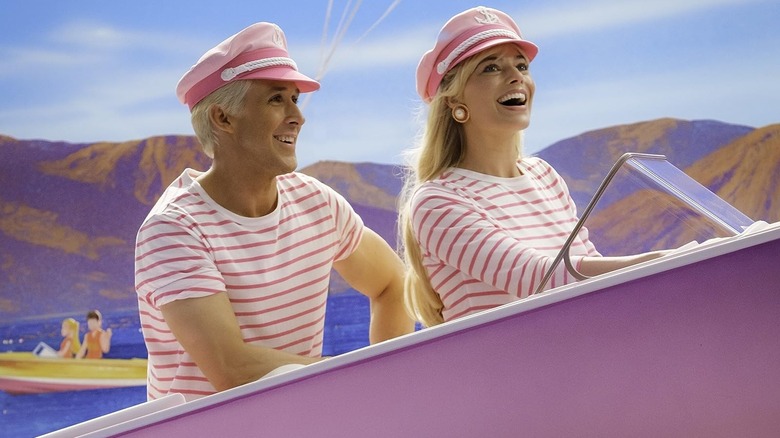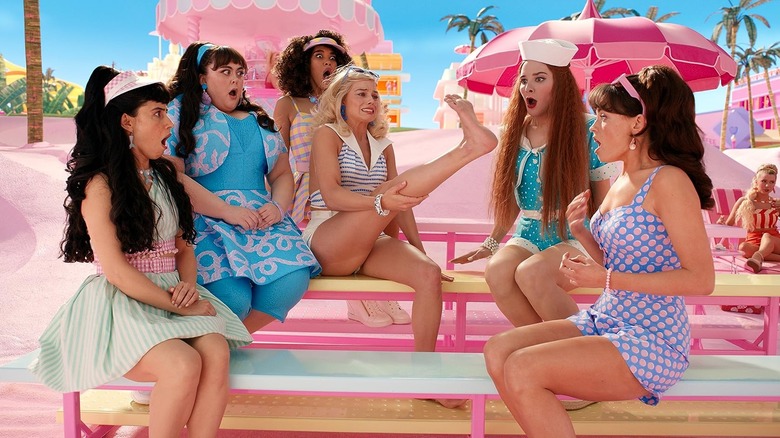How The Minds Of The Truman Show Helped Bring Greta Gerwig's Barbieland To Life
"Barbie" might be a multimillion-dollar corporate product based on a ridiculously lucrative multimedia property, but it's also an earnest love letter to cinema history. Of course, that's nothing new for co-writer and director Greta Gerwig. A quick glimpse at the multi-hyphenate's filmography will reveal she's never shied away from openly acknowledging her influences. "Frances Ha," the 2012 dramedy Gerwig starred in and co-wrote with the film's director and her "Barbie" co-writer/real-life partner, Noah Baumbach, overtly tips its hat to the French New Wave, as does Gerwig's semi-autobiographical directorial debut, "Lady Bird" (her answer to Francois Truffaut's "The 400 Blows").
When it comes to "Barbie," there's no missing the references to "The Wizard of Oz" and Gene Kelly musicals like "An American in Paris," nor the deliberate parallels between the red pill/blue pill scene from "The Matrix" and Stereotypical Barbie (Margot Robbie) consulting Weird Barbie (Kate McKinnon) about her sudden existential crisis. Gerwig has also spoken candidly about modeling Barbieland in the film after "The Truman Show," director Peter Weir's exemplary Jim Carrey dramedy about a man who resides in a utopian island community, unaware his home is actually an enormous soundstage populated by actors and televised to the world. Gerwig even went so far as to contact Weir about how to create what the Associated Press referred to as "an artificial world with emotional authenticity."
"He was so generous getting on the phone with me," Gerwig told the outlet. "I had this idea of making Barbieland basically an interior soundstage world. That was the concept. But as big as soundstages are, they're not the world. They're going to be small. You can only hang the lights so high."
Somebody help me, I'm being spontaneous!
"There's obviously parts of ['The Truman Show'] that are done on a stage, but then there are other parts of it that can't possibly be on a stage because it's too big, but it feels like it's on a stage, you know? Why does it feel like it's on a stage?" Gerwig continued. As Weir recounted to her, he and his crew used studio lights to make the film's real-world locations appear artificially lit:
"He explained to me they did shoot a lot of it outside in this community in Florida, but that they hung big stage lighting everywhere so it would look lit even though it was outside. And then he said it made everything like 120 degrees and that he did not suggest that. He was like, 'I wouldn't do that. It works but you might want to avoid making a place that's hot, hotter.'"
While Stereotypical Barbie is aware Barbieland exists separate from the real world, her journey in Gerwig's film resembles that of Truman Burbank's (Carrey) in "The Truman Show." Both characters are content with their "perfect" worlds until the cracks begin to show, forcing them to question the nature of their existence and what they even want from their lives. The subsequent changes in their behavior also prove comedically unsettling for those around them; the other Barbies and Kens panic at the sight of Stereotypical Barbie's flat feet, much like how the actors in "The Truman Show" don't know how to respond when Truman abruptly deviates from his daily routine.
In the end, "Barbie" and "The Truman Show" about both about characters freeing themselves from their fear of reality and the messiness that comes with it. From that perspective, the latter might be the most important influence of all on Gerwig's film.

